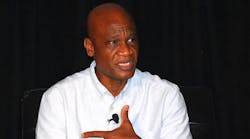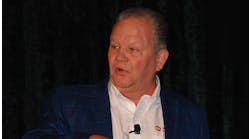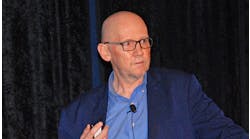Kraft Heinz, AB-InBev take digitalization plunge
Digital transformation is such a huge and torrential topic, many manufacturers can be forgiven for their reluctance to put a toe in, let alone jump in with both feet. Despite all this uncertainty, some brave end users such as Kraft Heinz and AB-InBev are exploring digital transformation and starting to take advantage of its capabilities.
“We’re at the start of our digital transformation journey, which is happening on two fronts with different starting points,” said Scott Ingles, head of international OT and automation at Kraft Heinz, who shares responsibility for 40 plants worldwide. “We have our U.S. business and platform that’s pretty mature, so we’re already collecting data, but have to decide how digital transformation can better analyze it, automate it, and get it to the right users for better decisions. However, we also have our international business that isn’t as mature, so we have to build more of the digital transformation infrastructure and find the right foundation for collecting data from crucial assets and analyzing it.”
Charles Tisdell, global director of automation and connected IIoT at AB-InBev, added, “Digital transformation is all about people transformation, too, and identifying gaps in data and equipment performance that need to be closed. We operate 256 facilities worldwide in six continental zones, so we also need to do digital transformation that can scale from North America to other global locations.”
Ingles and Tisdell headlined the wide-ranging panel discussion at the Food and Beverage Industry Forum focusing on consumer-packaged goods (CPG) on the first day of Automation Fair 2021 this week in Houston. They were joined by Colin Speakman, global director of consumer products at Kalypso, a Rockwell Automation company, and moderator Steve Deitzer, VP of CPG enterprise accounts at Rockwell Automation.
Learn to walk the digital path
Tisdell reported that AB-InBev is approaching digital transformation from an upside-down perspective by trying it out in frontline settings, and secure quick wins that can be scaled up to larger and more widespread locations. “We’re looking for user cases that can increase our yield on raw materials, while others are expected to increase equipment efficiency and reduce downtime, or give us better algorithms for increasing boiler efficiency,” said Tisdell. “Beyond developing bigger and better strategies, we also want to get people on the frontline to believe in these transformations, too.”
Ingles added that Kraft Heinz is examining digital transformation through the lens of its regular organizational pillars of quality, safety and production, and evaluating how digital transformation can assist its traditional objectives. “We’re asking what do we need to do and what do we want to do? We’re also identifying the information gaps between we data producers and data consumers, and seeing how we can close them,” added Ingles. “Our biggest driver remains how to deliver the best product fastest at the least cost. Of course, many people have been at home more due to the pandemic—it’s accelerated our digital transformation journey because we need to provide products even more quickly.”
Concepts to cases—and humans
Ingles and Tisdell acknowledged their colleagues and companies are striving to move digital transformation from proofs of concept (PoC) to genuine applications, even if they’re just micro-cases and micro-engagements in the beginning.
“For instance, when we work with a vendor, we’re starting with digital transformation end goals in mind, so we can build cases up to those levels,” said Tisdell. “There’s not one group driving digital transformation because it’s actually everywhere. Some or our organizations are excited about digital transformation, and we’re working with their functional areas on how they can use it to meet their individual challenges.
“AB-InBev uses a slew of capability models as part of its global management system, so we’re walking through those models with our coworkers, and looking at how digital transformation can solve them. Anyone can use digital transformation in their local setting, and then others can decide if what they’ve done is useful elsewhere based on their own capability models and drivers. This can go from idea, to model, to KPI, and then digital transformation turns into best practices that can be scaled up in any of our facilities.”
Ingles added, “We’re not just talking about digital transformation for improving machine vision or energy management. We also want to get our staff and leaders fully engaged because this is where the momentum has to start. And we’re not just talking about altering our culture. We’re talking about changing our capital expenditure (CapEx) models, too. Kraft Heinz has steering committees for each organization that needs to decide how they can use digital transformation and benefit from it.”
Ingles reported that Kraft Heinz has already implemented Ethernet gateways in multiple process applications to pave the way for upcoming digital transformation initiatives. “We’ve got many disparate data sources and databases in the U.S., so we have lots of traditional information. However, this is just the tip of the digital transformation iceberg we’re seeking to synergize,” said Ingles. “We need more infrastructure to use data better. However, we also know that our information technology (IT) and operations technology (OT) groups use different models, so they must come together in the same digital transformation environment and share and use each other’s data. This means breaking down barriers that have been in place for years.”
Likewise, Tisdell reported that AB-InBev is integrating its digital transformation efforts with advanced process control (APC) implementations it already has in place. “We’re also aware that OT and IT have to converge, but we’re also going to need sufficient cybersecurity to do so. We’ve already segmented out networks, but more virtualization will be needed, and IT can help bring it onto the OT side. Fortunately, our IT and OT organizations have a good relationship, so we’re confident we can continue putting in the right cybersecurity measures that will allow each side to share its data.”
Tisdell and Ingles added that digital transformation will also enable them to achieve long-sought sustainability goals and profit from them. “Kraft Heinz just announced its new sustainability initiative,” said Ingles. “We’re tracking our energy use and carbon footprint more closely, and bringing those capabilities to edge operations, not just at the site level, but down to the machine level.”
Tisdell added, “Sustainability will be the gift that keeps on giving, and digital transformation will allow us to achieve it. We’re connecting all of our energy environment and will have a SCADA solution that can view it all. This gift is the reason we need to build momentum for digital transformation.”
The editors of Control, Control Design and Smart Industry are reporting live from Automation Fair. When the event comes to a close, the editors will compile a report of the best, most important coverage from the event. Register now to pre-order the report and be among the first to receive it in your inbox. Pre-order your copy now.





